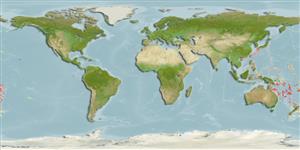>
Perciformes/Scorpaenoidei (Scorpionfishes) >
Peristediidae (Armored searobins or armored gurnards)
Etymology: Peristedion: Greek, peri = around + Greek, stethion = breast; longicornutum: Name from Latin 'longus' (tall or extended) and 'cornutum' (horned) which is the nominative singular neuter form; referring to the unusually long rostral projections of the new species. The species name is treated as a compound neuter adjective..
Environment: milieu / climate zone / depth range / distribution range
Ekologi
laut batidemersal; kisaran kedalaman 340 - 506 m (Ref. 116610). Tropical
Southwestern Pacific: Papua New Guinea, Solomon Sea, Solomon Islands and Vanuatu.
Size / Weight / umur
Maturity: Lm ? range ? - ? cm
Max length : 19.5 cm SL jantan/; (Ref. 116610)
Life cycle and mating behavior
Kematangan | Reproduksi, perkembang biakan | Pemijahan | telur-telur | Fecundity | Larva
Fricke, R., T. Kawai, T. Yato and H. Motomura, 2017. Peristedion longicornutum, a new species of armored gurnard from the western Pacific Ocean (Teleostei: Peristediidae). J. Ocean Sci. Found. 28:90-102. (Ref. 116610)
Status IUCN Red List (Ref. 130435)
ancaman kepada manusia
Harmless
penggunaan manusia
informasi lanjut
Nama-nama umumSinonim (persamaan)metabolismePemangsaEkotoksikologiReproduksi, perkembang biakanKematanganPemijahanSpawning aggregationFecunditytelur-telurpekembangan telor
Umur / Saiz
Pertumbuhan
panjang-berat
panjang-panjang
ukuran frekuensi
Morfometrik
Morfologi
Larva
Dinamika larva
pemulihan
Kelimpahan
BRUVS
AcuanBudidaya airprofil budidaya airStrainGenetikaElectrophoresesDiturunkanPenyakit-penyakitPengolahanNutrientsMass conversion
mitraGambarStamps, Coins Misc.Suara-suaraCiguateraKecepatanTipe renangArea insangOtolithsOtakPenglihatan / visi
Alat, peralatan
laporan khas
muat turun XML
Sumber internet
Estimates based on models
Phylogenetic diversity index (Ref.
82804): PD
50 = 0.5000 [Uniqueness, from 0.5 = low to 2.0 = high].
Bayesian length-weight: a=0.00617 (0.00305 - 0.01247), b=3.11 (2.94 - 3.28), in cm total length, based on LWR estimates for this Genus-body shape (Ref.
93245).
Trophic level (Ref.
69278): 3.5 ±0.3 se; based on size and trophs of closest relatives
Daya lenting (Ref.
120179): sedang, Waktu penggandaan populasi minimum 1.4 - 4.4 tahun (Preliminary K or Fecundity.).
Fishing Vulnerability (Ref.
59153): Low vulnerability (14 of 100).
